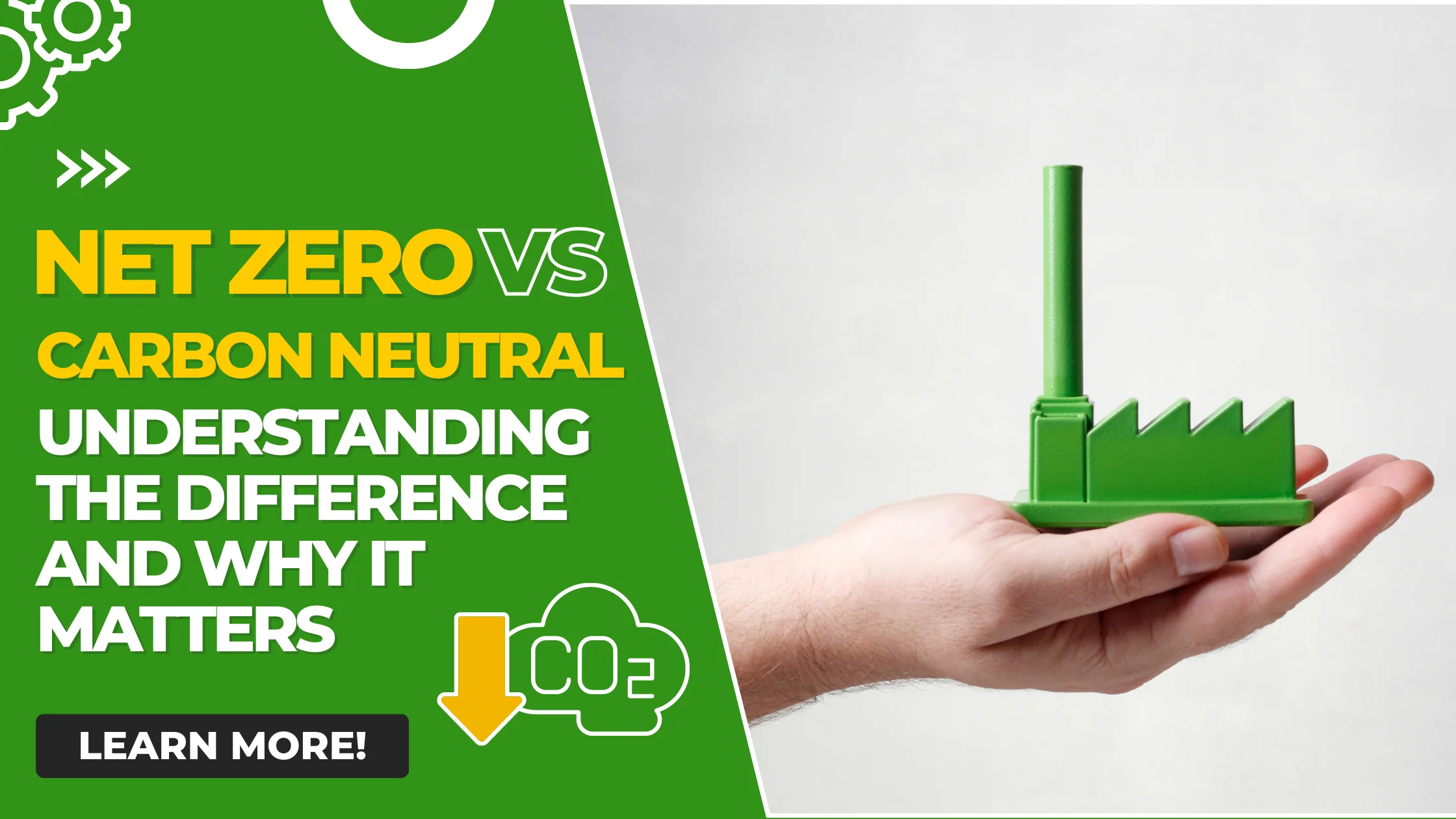In the urgent global conversation about climate change, terms like “carbon neutral” and “net zero” are frequently used, sometimes interchangeably. While both concepts aim to reduce humanity’s impact on the planet’s climate, they carry distinct meanings and implications for environmental action. Understanding this crucial difference is vital for businesses, policymakers, and individuals alike to effectively combat global warming and avoid “greenwashing” – the practice of making misleading claims about environmental efforts.
What Does Carbon Neutral Mean?
At its core, “carbon neutral” means that any carbon dioxide (CO2) released into the atmosphere from an activity is balanced by an equivalent amount being removed or offset. This balance is achieved by either reducing direct emissions or, more commonly, by investing in projects that absorb or avoid an equivalent amount of CO2 elsewhere.
How is Carbon Neutrality Achieved?
Companies or entities aiming for carbon neutrality typically follow a two-pronged approach:
- Reducing Emissions: Implementing energy efficiency measures, switching to renewable energy sources, and optimizing operations to lower their direct CO2 output.
- Offsetting Residual Emissions: For any emissions that cannot be eliminated, companies purchase “carbon credits”. These credits fund projects designed to remove CO2 from the atmosphere (e.g., reforestation, direct air capture) or prevent its release (e.g., renewable energy projects replacing fossil fuels).
The Role of Carbon Offsets
Carbon offsetting is central to carbon neutrality. Carbon sinks, such as forests, soils, and oceans, naturally absorb more carbon than they emit. Investment in the health of these natural sinks is a common form of offsetting. However, the effectiveness and credibility of carbon offsets have faced scrutiny. Critics argue that offsets can allow polluters to continue emitting without making fundamental changes to their operations, potentially leading to greenwashing. Concerns include the difficulty in verifying if an offset project truly provides “additionality” (i.e., whether the emissions reduction would not have happened anyway) and the permanence of carbon stored in natural sinks, which can be vulnerable to events like wildfires or logging.
What Does Net Zero Mean?
“Net Zero” is a more comprehensive and ambitious goal than carbon neutrality. It refers to a state where human-caused greenhouse gas (GHG) emissions are balanced by removing an equivalent amount from the atmosphere over a specified period, but with a strong emphasis on absolute emissions reduction first. This means cutting greenhouse gas emissions to as close to zero as possible, with any remaining, unavoidable emissions being neutralized by permanent removal from the atmosphere.
Key Characteristics of Net Zero
- Broader Scope: Unlike carbon neutrality, which often focuses solely on CO2 emissions and may limit its scope to direct and purchased energy emissions (Scope 1 and 2), Net Zero typically encompasses all greenhouse gases (e.g., methane, nitrous oxide, fluorinated gases) across a company’s entire value chain (Scope 1, 2, and 3 emissions).
- Scope 1 Emissions: Direct emissions from sources owned or controlled by the company (e.g., company vehicles, on-site fuel combustion).
- Scope 2 Emissions: Indirect emissions from the generation of purchased electricity, steam, heating, and cooling consumed by the company.
- Scope 3 Emissions: All other indirect emissions that occur in the company’s value chain, both upstream (e.g., raw material production, transportation by suppliers) and downstream (e.g., use of sold products, waste disposal). For many companies, Scope 3 emissions represent the vast majority of their total footprint.
- Emphasis on Absolute Reductions: The primary focus of a net-zero strategy is to drastically reduce emissions, typically by at least 90%, before relying on removals. This involves fundamental changes to operations, supply chains, and product lifecycles.
- Permanent Removals (Not Just Offsets): For the small percentage of residual emissions that cannot be eliminated, net-zero strategies require neutralization through permanent carbon removal and storage methods. This is distinct from many carbon offsetting projects, which may involve avoidance or temporary storage.
- Science-Based Targets (SBTi): Many credible net-zero commitments are aligned with science-based targets (SBTs), particularly those validated by the Science Based Targets initiative (SBTi). The SBTi provides a framework for companies to set targets consistent with limiting global warming to 1.5°C, requiring significant near-term and long-term emission reductions across all scopes.
Why the Distinction Matters
The nuances between carbon neutral and net zero are critical for several reasons:
- Climate Ambition: Net zero signifies a far more ambitious and impactful commitment to climate action. It prioritizes deep decarbonization and systemic change over simply compensating for emissions. Achieving global net-zero emissions by 2050 is essential to stabilize temperature increases at 1.5°C, as called for in the Paris Agreement.
- Avoiding Greenwashing: Companies claiming “carbon neutrality” solely through purchasing inexpensive, low-quality carbon offsets without significant internal emission reductions can be accused of greenwashing. Net zero, particularly when verified by standards like SBTi, demands genuine transformation.
- Holistic Impact: By including Scope 3 emissions, net zero addresses the full environmental footprint of an organization, encompassing its entire value chain. This encourages collaboration with suppliers and customers to drive broader decarbonization across industries.
- Long-Term Solutions: Net zero aims for systemic changes that permanently reduce reliance on fossil fuels and eliminate greenhouse gas emissions, rather than relying on potentially temporary or less effective offsetting mechanisms.
Pathways to Achieving Net Zero
Achieving net zero requires a comprehensive, transformative approach across all sectors. Key strategies include:
- Transition to Renewable Energy: Shifting from fossil fuels to wind, solar, hydroelectric power, and other renewable sources is fundamental.
- Energy Efficiency: Enhancing efficiency in buildings, transportation, and industrial processes to reduce overall energy demand.
- Electrification: Promoting electric vehicles and electrifying industrial processes where feasible.
- Sustainable Agriculture: Implementing practices to reduce methane emissions and promoting agroforestry.
- Carbon Capture and Storage (CCS): Technologies that capture CO2 emissions at their source and store them underground for unavoidable emissions.
- Reforestation and Afforestation: Planting trees and restoring forests, primarily for residual emissions that are difficult to abate.
- Policy and Collaboration: Strong government policies and international collaboration are crucial to accelerate the transition, alongside private sector commitment.
Conclusion
While carbon neutrality has played a role in raising awareness and encouraging initial steps toward environmental responsibility, “Net Zero” has emerged as the unequivocal gold standard for corporate and national climate action. It represents a commitment to deep, absolute emissions reductions across all greenhouse gases and entire value chains, with removal technologies used only for truly unavoidable residual emissions. As the world races to meet the urgent targets of the Paris Agreement, understanding and implementing genuine net-zero strategies will be paramount to securing a sustainable future.

